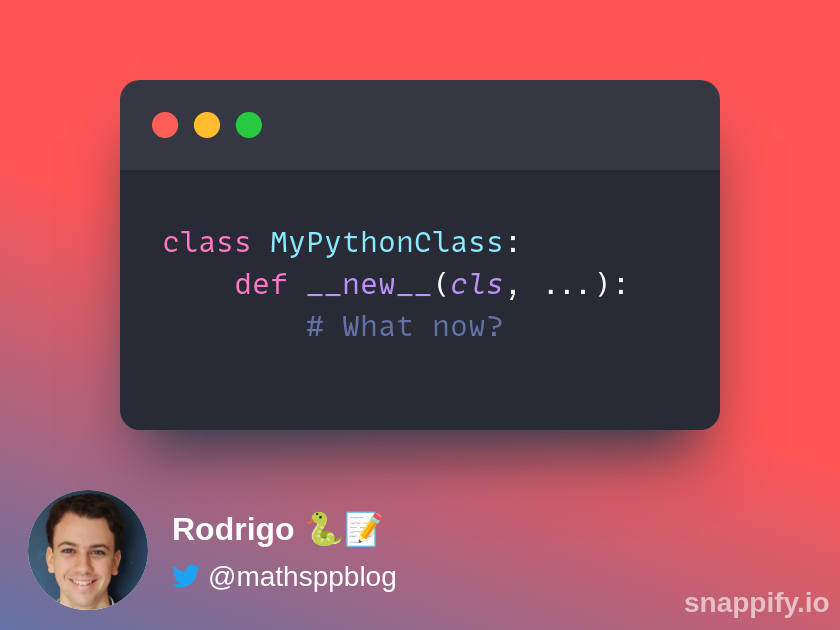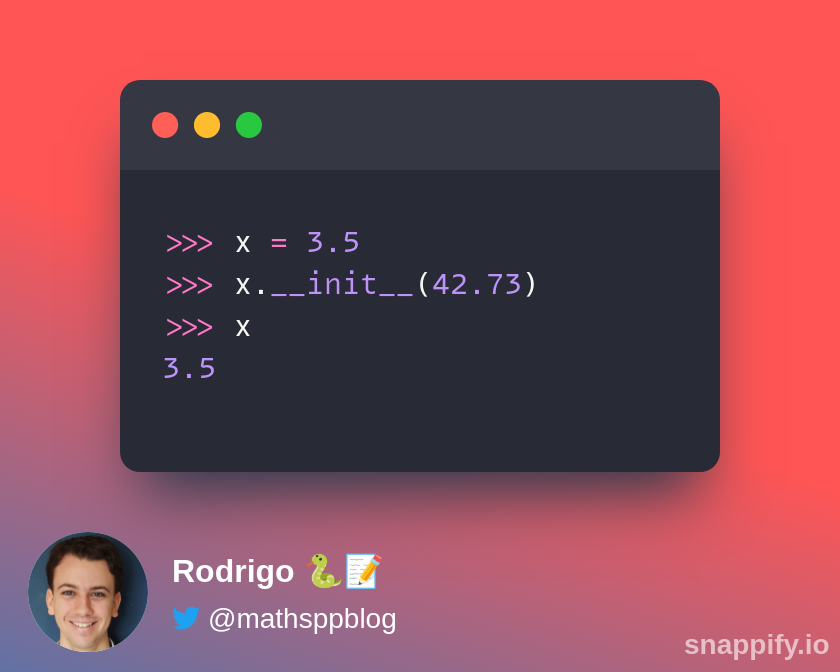
#1: the built-in `reversed`:
The built-in `reversed` accepts a sequence and returns an object that knows how to iterate over that sequence IN REVERSE.
Hence, `reversed`.
Notice it doesn't return a list:
The built-in `reversed` accepts a sequence and returns an object that knows how to iterate over that sequence IN REVERSE.
Hence, `reversed`.
Notice it doesn't return a list:

The `list_reverseiterator` object that is returned is “linked” to the original list...
So, if you change the original list, the reverse iterator will notice:![>>> lst = [42, 73, 0] >>> rev = reversed(lst) >>> lst[1] = 9](/images/1px.png)
So, if you change the original list, the reverse iterator will notice:
![>>> lst = [42, 73, 0] >>> rev = reversed(lst) >>> lst[1] = 9](https://pbs.twimg.com/media/Fa_g934XoAAkYJC.jpg)
#2: slicing with `[::-1]`:
The slicing syntax with brackets `[]` and colons `:` accepts a “step” that can be negative.
If the “start” and “stop” are omitted and the “step” is -1, we get a copy in the reverse order:![>>> lst = [42, 73, 0] >>> lst[::-1] [0, 73, 42]](/images/1px.png)
The slicing syntax with brackets `[]` and colons `:` accepts a “step” that can be negative.
If the “start” and “stop” are omitted and the “step” is -1, we get a copy in the reverse order:
![>>> lst = [42, 73, 0] >>> lst[::-1] [0, 73, 42]](https://pbs.twimg.com/media/Fa_g-gwWAAA3c7o.png)
Slices in Python 🐍 are regular objects, so you can also name them.
Thus, you could go as far as creating a named slice to reverse lists, and then use it:![>>> lst [42, 73, 0] >>> reverse = slice(None, None, -1) >>>](/images/1px.png)
Thus, you could go as far as creating a named slice to reverse lists, and then use it:
![>>> lst [42, 73, 0] >>> reverse = slice(None, None, -1) >>>](https://pbs.twimg.com/media/Fa_g_J_XoAAZxRt.jpg)
Notice that slices are not “linked” to the original list.
That's because slicing creates a copy of the list.
So, if you change the elements in a given index, the reversed list will not notice:![>>> lst = [42, 73, 0] # Original list. >>> rev = lst[::-1]](/images/1px.png)
That's because slicing creates a copy of the list.
So, if you change the elements in a given index, the reversed list will not notice:
![>>> lst = [42, 73, 0] # Original list. >>> rev = lst[::-1]](https://pbs.twimg.com/media/Fa_g_2IWYAA6xVS.jpg)
Slicing is very powerful and useful, and that is why I wrote a whole chapter of my free book “Pydon'ts” on the subject.
The link to the free book is in my Twitter profile and the chapter can also be read online:
mathspp.com/blog/pydonts/i…
The link to the free book is in my Twitter profile and the chapter can also be read online:
mathspp.com/blog/pydonts/i…
#3: the method `.reverse`:
Lists have a method `.reverse` that reverses the list IN PLACE.
What this means is that you do not get a return value with the reversed list...
Instead, the list itself gets turned around 🙃![>>> lst = [42, 73, 0] >>> lst.reverse() >>> lst [0, 73, 42]](/images/1px.png)
Lists have a method `.reverse` that reverses the list IN PLACE.
What this means is that you do not get a return value with the reversed list...
Instead, the list itself gets turned around 🙃
![>>> lst = [42, 73, 0] >>> lst.reverse() >>> lst [0, 73, 42]](https://pbs.twimg.com/media/Fa_hAi4XgAAT3Q2.png)
There you have it, three ways in which you can reverse a Python list.
I hope this was useful and, if it was, follow me @mathsppblog for more daily Python knowledge 😉
Extra internet points if you retweet this thread for me 🙏
I hope this was useful and, if it was, follow me @mathsppblog for more daily Python knowledge 😉
Extra internet points if you retweet this thread for me 🙏
Here is a quick summary:
Reverse a Python list with:
1. the built-in `reversed` that will notice changes to the original list;
2. slicing `[::-1]` that creates a copy of the original list; and
3. the method `.reverse` that reverses a list in place.
Reverse a Python list with:
1. the built-in `reversed` that will notice changes to the original list;
2. slicing `[::-1]` that creates a copy of the original list; and
3. the method `.reverse` that reverses a list in place.
• • •
Missing some Tweet in this thread? You can try to
force a refresh

![>>> lst = [42, 73, 0] >>> rev1 = reversed(lst) >>> rev2 = ls](https://pbs.twimg.com/media/Fa_g8XbWQAAKBMr.png)





![>>> class C: ... __slots__ = [] ... >>> c = C() >>> c.r](https://pbs.twimg.com/media/FZTI6sGWQAAOxsU.jpg)
![class Person(tuple): __slots__ = [] def __new__(cls,](https://pbs.twimg.com/media/FZTI7dUX0AAXASC.jpg)


![>>> mylist = [73, 42] >>> mylist.__init__((1, 3, 5)) >>> myl](https://pbs.twimg.com/media/FW1DqfSXwAEH_QS.jpg)






